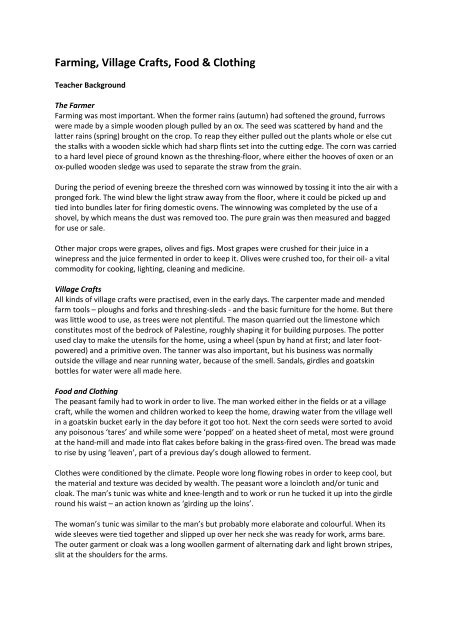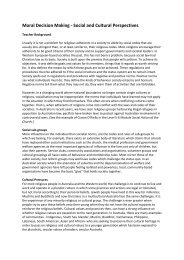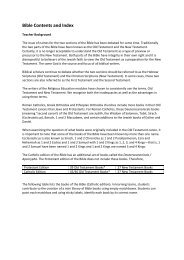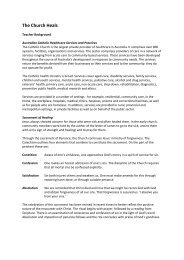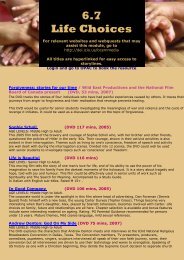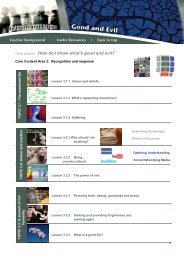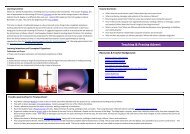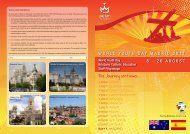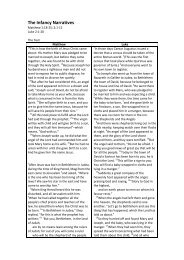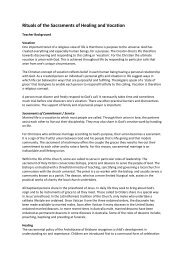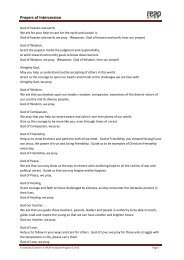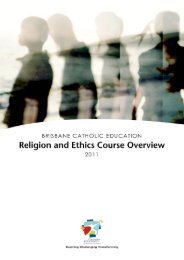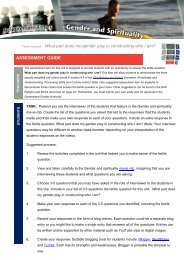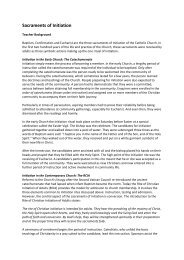Farming, Village Crafts, Food & Clothing
Farming, Village Crafts, Food & Clothing
Farming, Village Crafts, Food & Clothing
You also want an ePaper? Increase the reach of your titles
YUMPU automatically turns print PDFs into web optimized ePapers that Google loves.
<strong>Farming</strong>, <strong>Village</strong> <strong>Crafts</strong>, <strong>Food</strong> & <strong>Clothing</strong><br />
Teacher Background<br />
The Farmer<br />
<strong>Farming</strong> was most important. When the former rains (autumn) had softened the ground, furrows<br />
were made by a simple wooden plough pulled by an ox. The seed was scattered by hand and the<br />
latter rains (spring) brought on the crop. To reap they either pulled out the plants whole or else cut<br />
the stalks with a wooden sickle which had sharp flints set into the cutting edge. The corn was carried<br />
to a hard level piece of ground known as the threshing-floor, where either the hooves of oxen or an<br />
ox-pulled wooden sledge was used to separate the straw from the grain.<br />
During the period of evening breeze the threshed corn was winnowed by tossing it into the air with a<br />
pronged fork. The wind blew the light straw away from the floor, where it could be picked up and<br />
tied into bundles later for firing domestic ovens. The winnowing was completed by the use of a<br />
shovel, by which means the dust was removed too. The pure grain was then measured and bagged<br />
for use or sale.<br />
Other major crops were grapes, olives and figs. Most grapes were crushed for their juice in a<br />
winepress and the juice fermented in order to keep it. Olives were crushed too, for their oil- a vital<br />
commodity for cooking, lighting, cleaning and medicine.<br />
<strong>Village</strong> <strong>Crafts</strong><br />
All kinds of village crafts were practised, even in the early days. The carpenter made and mended<br />
farm tools – ploughs and forks and threshing-sleds - and the basic furniture for the home. But there<br />
was little wood to use, as trees were not plentiful. The mason quarried out the limestone which<br />
constitutes most of the bedrock of Palestine, roughly shaping it for building purposes. The potter<br />
used clay to make the utensils for the home, using a wheel (spun by hand at first; and later footpowered)<br />
and a primitive oven. The tanner was also important, but his business was normally<br />
outside the village and near running water, because of the smell. Sandals, girdles and goatskin<br />
bottles for water were all made here.<br />
<strong>Food</strong> and <strong>Clothing</strong><br />
The peasant family had to work in order to live. The man worked either in the fields or at a village<br />
craft, while the women and children worked to keep the home, drawing water from the village well<br />
in a goatskin bucket early in the day before it got too hot. Next the corn seeds were sorted to avoid<br />
any poisonous ‘tares’ and while some were ‘popped’ on a heated sheet of metal, most were ground<br />
at the hand-mill and made into flat cakes before baking in the grass-fired oven. The bread was made<br />
to rise by using ‘leaven’, part of a previous day’s dough allowed to ferment.<br />
Clothes were conditioned by the climate. People wore long flowing robes in order to keep cool, but<br />
the material and texture was decided by wealth. The peasant wore a loincloth and/or tunic and<br />
cloak. The man’s tunic was white and knee-length and to work or run he tucked it up into the girdle<br />
round his waist – an action known as ‘girding up the loins’.<br />
The woman’s tunic was similar to the man’s but probably more elaborate and colourful. When its<br />
wide sleeves were tied together and slipped up over her neck she was ready for work, arms bare.<br />
The outer garment or cloak was a long woollen garment of alternating dark and light brown stripes,<br />
slit at the shoulders for the arms.
The wealthy could afford brightly dyed cloth and used a short jacket overt he tunic. Often the<br />
clothes indicate a man’s profession – the special dress of the priests, for example, or the rabbi’s blue<br />
fringed robe. Footwear, when worn at all by the poor man, consisted of a cowhide sole fastened to<br />
the ankle by a leather thong passing between the large and second toe; though his richer friend<br />
might wear leather slippers. Because the head had to be protected from the sun a turban was worn,<br />
or a square of cloth held on to the head by a cord. There were no such luxuries as night attire for the<br />
common man. He simply loosened his girdle and wrapped himself in his cloak.


